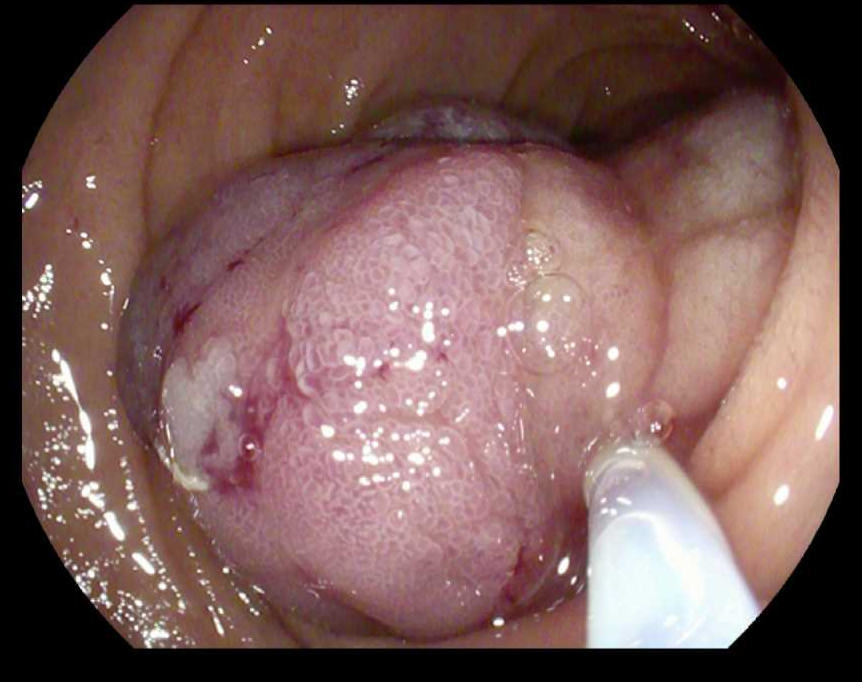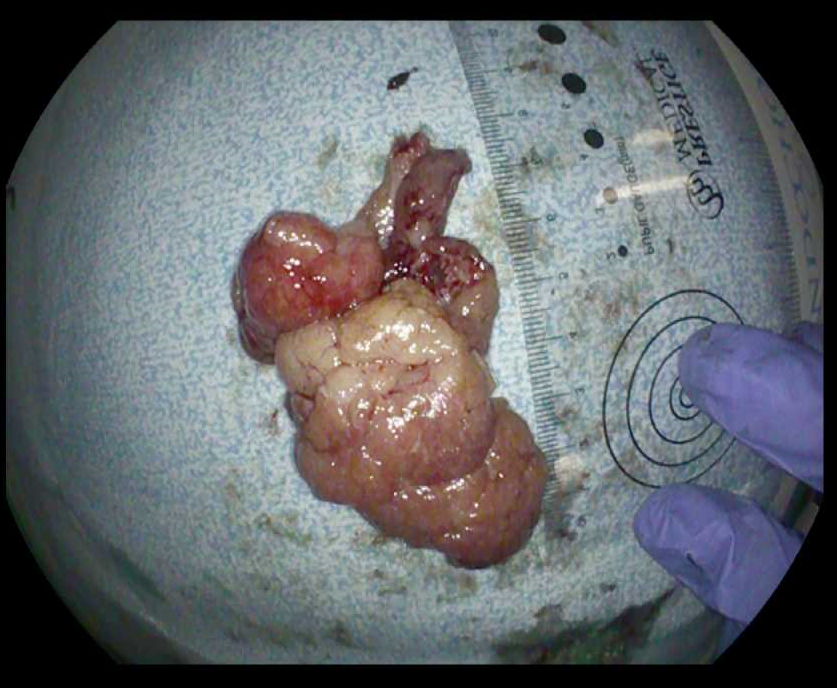Tuesday Poster Session
Category: Small Intestine
P6302 - The Largest Brunner's Gland Hamartoma Reported to Be Endoscopically Resected En Bloc
Tuesday, October 28, 2025
10:30 AM - 4:00 PM PDT
Location: Exhibit Hall

Maxwell S. Madani, BA (he/him/his)
George Washington University School of Medicine and Health Sciences
Washington, DC
Presenting Author(s)
Maxwell S. Madani, BA1, Jasjit Multani, MD2, Vinay Rao, MD3, Raymond Janowski, MD3, Marie L. Borum, MD, EdD, MPH, FACG4
1George Washington University School of Medicine and Health Sciences, Washington, DC; 2Unity Health-White County Medical Center, Searcy, AR; 3George Washington University Hospital, Washington, DC; 4Division of Gastroenterology and Liver Disease, Department of Medicine, George Washington University School of Medicine and Health Sciences, Washington, DC
Introduction: Brunner’s gland hamartomas (BGH) are benign tumors typically located in the proximal duodenum. These tumors are rare, making up less than 1% of small bowel tumors and 5-10% of benign duodenal tumors. These lesions are typically found incidentally on EGD or occasionally on CT or MRI. Large tumors can cause pain, obstruction, intussusception or bleeding. There are no guidelines for management of BGH given their rarity. Endoscopic mucosal resection (EMR), or submucosal dissection (ESD) for large or complicated tumors is preferred. However, there can be reluctance to consider endoscopic removal due to concerns about retrieval that requires passage through the pylorus or esophageal sphincters. Laparoscopic or open surgery has been employed for patients with large lesions or high tumor burden. We present the largest BGH reported to have been endoscopically resected en bloc. This case highlights the importance of considering EMR or ESD for large duodenal lesions as a potentially more time sensitive, lower risk approach for resection of large BGH.
Case Description/
Methods: 75-year-old male with hypertension, hyperlipidemia, chronic hepatitis C, prior appendectomy and recurrent small bowel obstructions was admitted with melena. Labs revealed hemoglobin of 3.7 g/dL and CT angiography showed active extravasation from a large duodenal mass extending to the second portion of the duodenum. He was resuscitated with intravenous fluids and transfusion of 4 units of packed red cells. EGD confirmed a polypoid, pedunculated mass measuring 8cm x 4cm with stigmata of recent bleeding in the proximal duodenal bulb extending into the duodenal sweep (Figure 1-2). The mass was lifted with methylene blue lifting agent and removed en bloc with hot snare. Bleeding prevention was addressed with 4 hemostatic Mantis clips. Intubation for airway protection allowed for uncomplicated retrieval. Histologic review revealed BGH. He had no evidence of recurrent bleeding during the hospitalization.
Discussion: En bloc EMR of a large BGH is a rarely performed, technically challenging procedure. EMR of an 8 cm BGH has management advantages when compared to piecemeal resection, ESD, or surgical resection offering potentially lower bleeding and perforation rates with less likelihood of recurrence due to complete excision. Additionally, histopathologic analysis is optimized with complete resection. While no specific guidelines exist for resection of large duodenal lesions, en bloc EMR should be increasingly considered where possible.

Figure: Figure 1) Endoscopic view of en bloc resection of Brunner gland hamartoma in the distal duodenal bulb.

Figure: Figure 2) Resected 8 cm x 4 cm Brunner gland hamartoma, base located at top end of image.
Disclosures:
Maxwell Madani indicated no relevant financial relationships.
Jasjit Multani indicated no relevant financial relationships.
Vinay Rao indicated no relevant financial relationships.
Raymond Janowski indicated no relevant financial relationships.
Marie Borum indicated no relevant financial relationships.
Maxwell S. Madani, BA1, Jasjit Multani, MD2, Vinay Rao, MD3, Raymond Janowski, MD3, Marie L. Borum, MD, EdD, MPH, FACG4. P6302 - The Largest Brunner's Gland Hamartoma Reported to Be Endoscopically Resected En Bloc, ACG 2025 Annual Scientific Meeting Abstracts. Phoenix, AZ: American College of Gastroenterology.
1George Washington University School of Medicine and Health Sciences, Washington, DC; 2Unity Health-White County Medical Center, Searcy, AR; 3George Washington University Hospital, Washington, DC; 4Division of Gastroenterology and Liver Disease, Department of Medicine, George Washington University School of Medicine and Health Sciences, Washington, DC
Introduction: Brunner’s gland hamartomas (BGH) are benign tumors typically located in the proximal duodenum. These tumors are rare, making up less than 1% of small bowel tumors and 5-10% of benign duodenal tumors. These lesions are typically found incidentally on EGD or occasionally on CT or MRI. Large tumors can cause pain, obstruction, intussusception or bleeding. There are no guidelines for management of BGH given their rarity. Endoscopic mucosal resection (EMR), or submucosal dissection (ESD) for large or complicated tumors is preferred. However, there can be reluctance to consider endoscopic removal due to concerns about retrieval that requires passage through the pylorus or esophageal sphincters. Laparoscopic or open surgery has been employed for patients with large lesions or high tumor burden. We present the largest BGH reported to have been endoscopically resected en bloc. This case highlights the importance of considering EMR or ESD for large duodenal lesions as a potentially more time sensitive, lower risk approach for resection of large BGH.
Case Description/
Methods: 75-year-old male with hypertension, hyperlipidemia, chronic hepatitis C, prior appendectomy and recurrent small bowel obstructions was admitted with melena. Labs revealed hemoglobin of 3.7 g/dL and CT angiography showed active extravasation from a large duodenal mass extending to the second portion of the duodenum. He was resuscitated with intravenous fluids and transfusion of 4 units of packed red cells. EGD confirmed a polypoid, pedunculated mass measuring 8cm x 4cm with stigmata of recent bleeding in the proximal duodenal bulb extending into the duodenal sweep (Figure 1-2). The mass was lifted with methylene blue lifting agent and removed en bloc with hot snare. Bleeding prevention was addressed with 4 hemostatic Mantis clips. Intubation for airway protection allowed for uncomplicated retrieval. Histologic review revealed BGH. He had no evidence of recurrent bleeding during the hospitalization.
Discussion: En bloc EMR of a large BGH is a rarely performed, technically challenging procedure. EMR of an 8 cm BGH has management advantages when compared to piecemeal resection, ESD, or surgical resection offering potentially lower bleeding and perforation rates with less likelihood of recurrence due to complete excision. Additionally, histopathologic analysis is optimized with complete resection. While no specific guidelines exist for resection of large duodenal lesions, en bloc EMR should be increasingly considered where possible.

Figure: Figure 1) Endoscopic view of en bloc resection of Brunner gland hamartoma in the distal duodenal bulb.

Figure: Figure 2) Resected 8 cm x 4 cm Brunner gland hamartoma, base located at top end of image.
Disclosures:
Maxwell Madani indicated no relevant financial relationships.
Jasjit Multani indicated no relevant financial relationships.
Vinay Rao indicated no relevant financial relationships.
Raymond Janowski indicated no relevant financial relationships.
Marie Borum indicated no relevant financial relationships.
Maxwell S. Madani, BA1, Jasjit Multani, MD2, Vinay Rao, MD3, Raymond Janowski, MD3, Marie L. Borum, MD, EdD, MPH, FACG4. P6302 - The Largest Brunner's Gland Hamartoma Reported to Be Endoscopically Resected En Bloc, ACG 2025 Annual Scientific Meeting Abstracts. Phoenix, AZ: American College of Gastroenterology.
